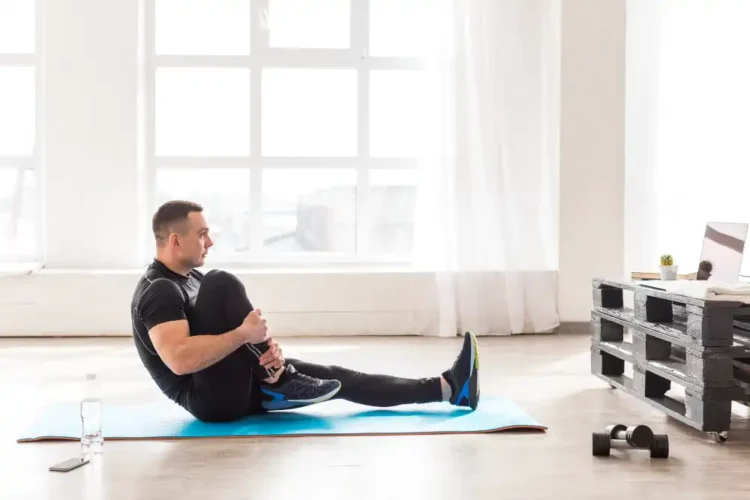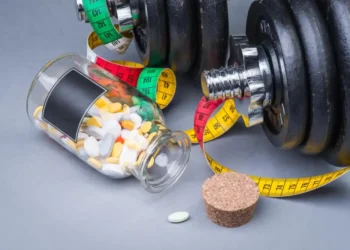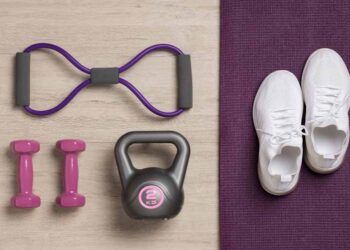Did you know that adding active recovery to your fitness plan can do wonders? It involves light exercises after a tough workout. This practice brings a lot of benefits to your body. For instance, it can lessen the lactic acid in your muscles and boost blood flow. It also helps improve how flexible you are. Active recovery can truly change how you exercise and feel every day.
Let’s look into why active recovery is so good for your health. It’s not only about the body but also how you feel mentally.
Key Takeaways:
- Active recovery workouts involve low-intensity exercises after intense workouts.
- Active recovery reduces lactic acid buildup, promotes blood flow, and keeps muscles flexible.
- Incorporating active recovery can enhance muscle repair, prevent injuries, and improve overall fitness.
- Active recovery contributes to mental well-being by reducing stress and promoting a positive mindset.
- Consult with a healthcare professional and listen to your body for safe and effective active recovery.
The Importance of Active Recovery for Muscle Repair
Active recovery is key for muscle repair and to recover after hard workouts. Doing light exercises like walking, swimming, or yoga boosts blood flow to muscles. This brings oxygen and nutrients needed for healing (benefits of active recovery for muscle repair). It cuts muscle soreness, stiffness, and the chance of getting hurt.
After working out hard, there’s often lactic acid in your muscles. This can make you feel tired and your muscles tight. But, active recovery helps clear this lactic acid out, which makes your muscles recover faster (active recovery exercises for muscle recovery). By doing easy activities, you get rid of waste and keep your muscles healthy.
Having regular active recovery times is good for muscle repair and gets you ready for more workouts. It lets your muscles heal right. Then you can get back your strength and stamina, doing better in future sessions.
Choosing active recovery for your routine is smart if you want to get fit without getting hurt. It’s a way to focus on muscle repair using low-intensity activities. This keeps your progress moving forward (active recovery benefits for muscle repair).
Always check how your body feels and change your exercises when needed. Pick activities that you like and help you reach your goals (active recovery exercises for muscle recovery). With active recovery as a regular part of your plan, you can boost muscle repair, better your recovery, and do well in your fitness journey.
| Benefits of Active Recovery for Muscle Repair |
|---|
| Promotes blood flow to the muscles |
| Delivers oxygen and nutrients necessary for healing |
| Reduces muscle soreness and stiffness |
| Decreases the risk of injuries |
| Clears lactic acid buildup in the muscles |
| Enhances muscle repair and recovery |
| Improves overall performance in future workouts |
The Benefits of Active Recovery for Flexibility and Injury Prevention
Active recovery is great for preventing injuries and staying flexible. By adding specific exercises to your routine, you can get more flexible and lower the chance of getting hurt. This also helps your overall fitness.
Doing activities like stretching, swimming, or yoga keeps your muscles and joints moving. It makes you more flexible and helps you move better. This is key for staying loose and being at your best. And it improves how well you do in sports, getting you to your top level.
Active recovery is also key in stopping injuries. These light workouts boost blood flow, cleaning waste from your muscles. This lowers swelling and stops some injuries. Doing stretches and using foam rollers helps a lot. They get more blood to your muscles and relieve stress.
Benefits of Active Recovery for Flexibility:
- Improves range of motion and joint flexibility
- Enhances athletic performance
- Reduces the risk of muscle imbalances and strains
- Prevents stiffness and maintains mobility
Active Recovery Exercises for Flexibility:
- Stretching: Mix up how you stretch to get more flexible and avoid stiff muscles.
- Yoga: Do yoga poses that stretch your muscles and make you more flexible and calm.
- Swimming: Swim lightly to make your joints move better and get more flexible all over.
- Myofascial Release with Foam Roller: Roll on a foam roller to relax your muscles, get more flexible, and feel less sore.
Make active recovery a big part of your routine to get these benefits. Remember to rest when needed and talk to a doctor if you’re unsure. Dedicate time to active rest, and you’ll see big improvements in how flexible you are and how safe you are from getting hurt.
| Benefits of Active Recovery for Flexibility | Active Recovery Exercises for Flexibility |
|---|---|
| Improves range of motion and joint flexibility | Stretching |
| Enhances athletic performance | Yoga |
| Reduces the risk of muscle imbalances and strains | Swimming |
| Prevents stiffness and maintains mobility | Myofascial Release with Foam Roller |
Active Recovery and Its Benefits for Mental Well-being
Active recovery isn’t just for the body. Activities like walking, cycling, or light jogging can uplift your mood. They help release endorphins, known as the “feel-good” hormones. This can lower stress, anxiety, and even symptoms of depression.
Research shows that staying physically active helps fight stress’s bad effects. It triggers the production of chemicals like serotonin and dopamine. These are essential for a good mood. Including active recovery in your life can help you deal with stress better.
It’s a great way to take a break from intense workouts. This prevents you from getting tired or bored with exercise. Doing lighter activities helps your mind relax. It’s a key part of keeping stress in check and living a balanced life.
Active recovery is also linked to better sleep. Regular exercise can improve both how long you sleep and its quality. This leads to sharper thinking and a happier mood. So, adding these exercises can really improve your sleep and mental health.
“Active recovery not only refreshes your body but also recharges your mind, allowing you to approach daily challenges with greater clarity and emotional well-being.” – Dr. Rebecca Johnson, Clinical Psychologist
Adding active recovery to your routine improves your outlook on life. By boosting your feel-good hormones and reducing stress, it’s great for your mind. It’s key to staying motivated and looking ahead positively.
| Benefits of Active Recovery for Mental Well-being |
|---|
| Reduces stress and anxiety |
| Elevates mood and promotes a sense of well-being |
| Prevents burnout and helps maintain a healthy relationship with exercise |
| Improves sleep quality and enhances cognitive function |
Make active recovery a part of your fitness plan for a happy mind. So, put your running shoes on or grab your bike. It’s time to enjoy the huge mental benefits of active recovery!
Conclusion
Active recovery greatly impacts your fitness journey and health. Adding low-intensity exercises brings many benefits. It helps your muscles heal, makes you more flexible, lowers injury risks, and boosts your mood.
Finding ways to do active recovery is easy. You can walk, swim, do yoga, or just stretch. These activities should match what you like and what you need to achieve. And it’s always smart to check with a doctor and pay attention to how your body feels.
Discovering active recovery’s perks changes how you exercise. Low-intensity exercises are not something small. They are your way to give your body proper rest and still get closer to your fitness dreams. Start using active recovery now to upgrade your workout and your life.














